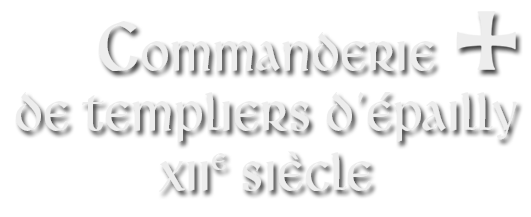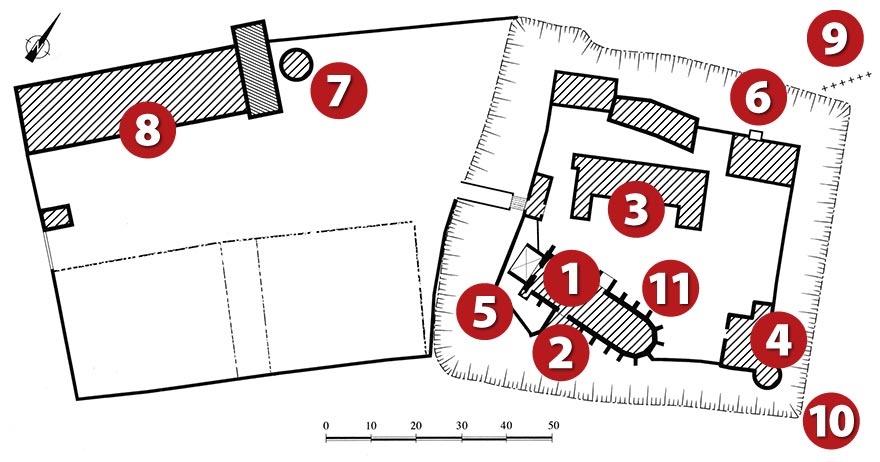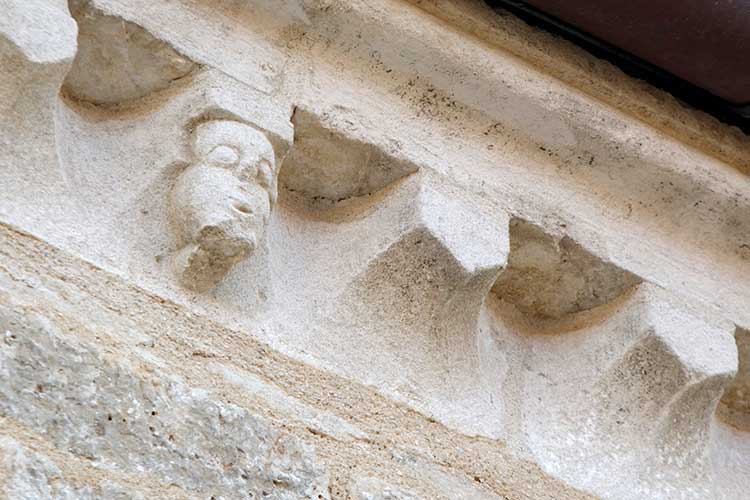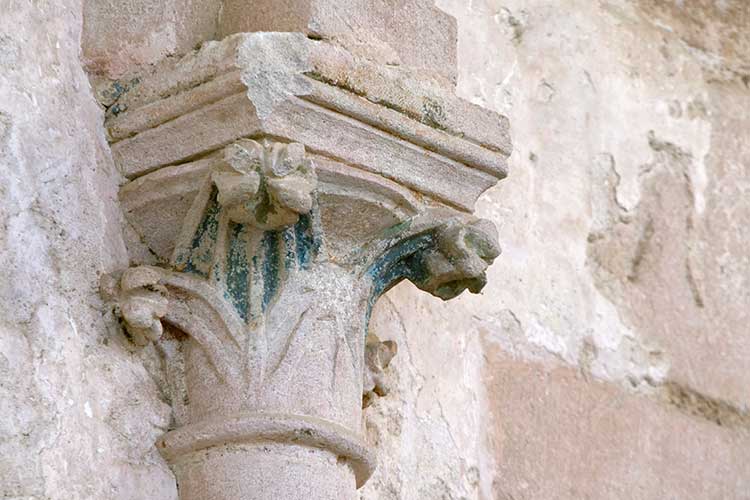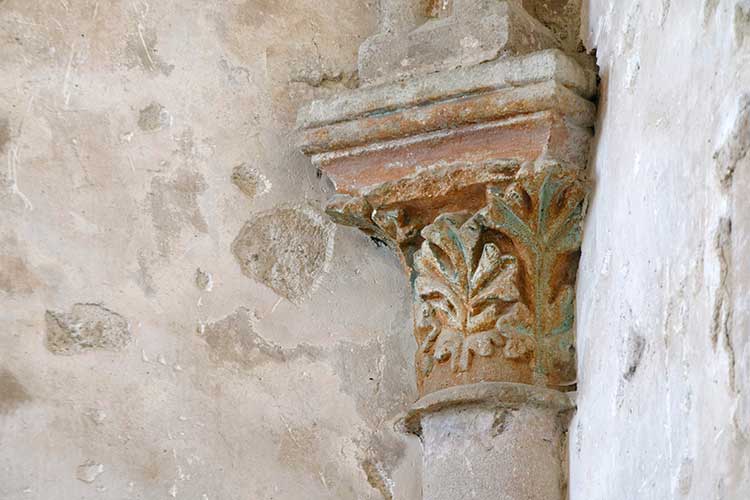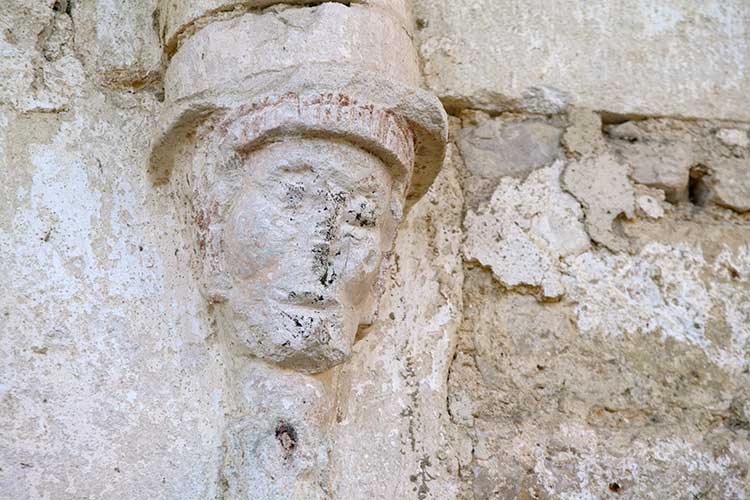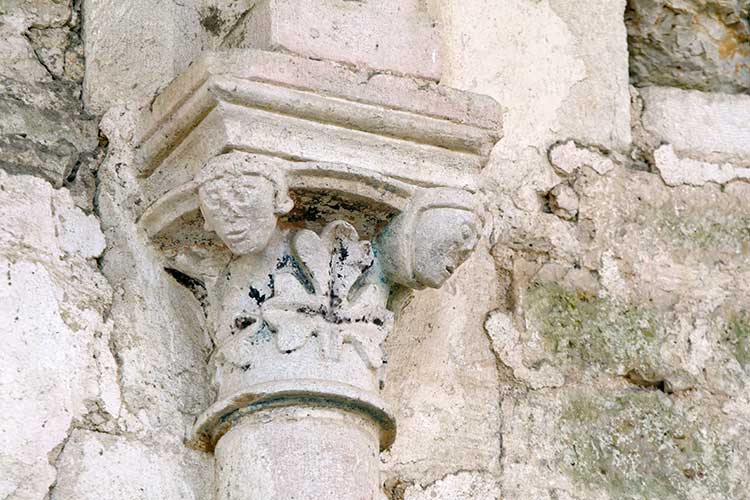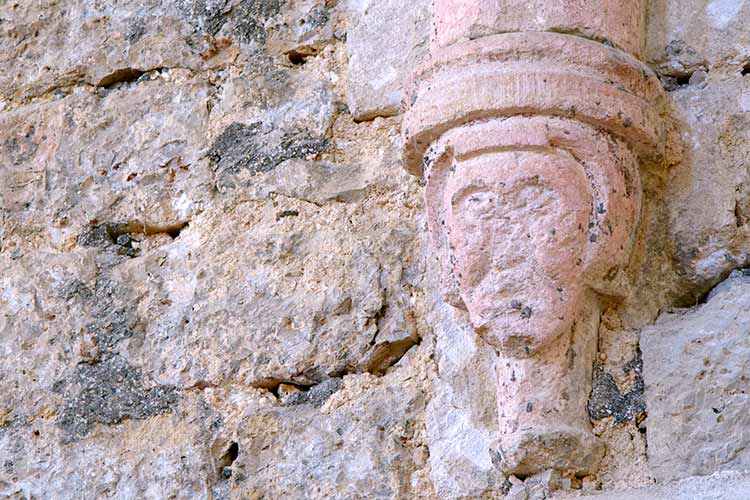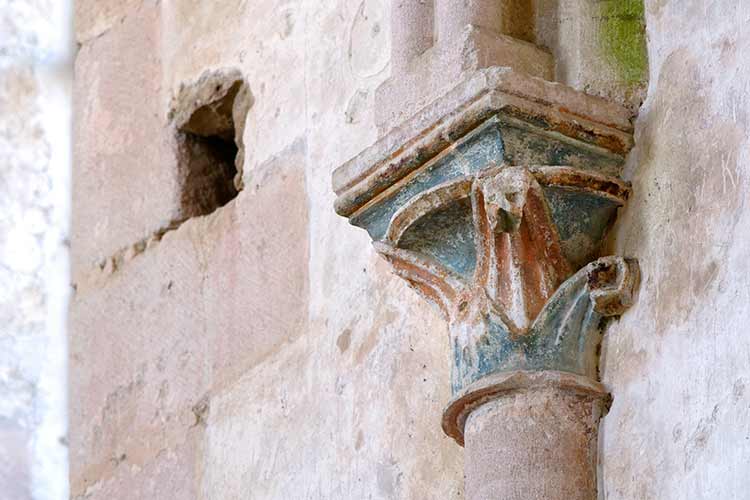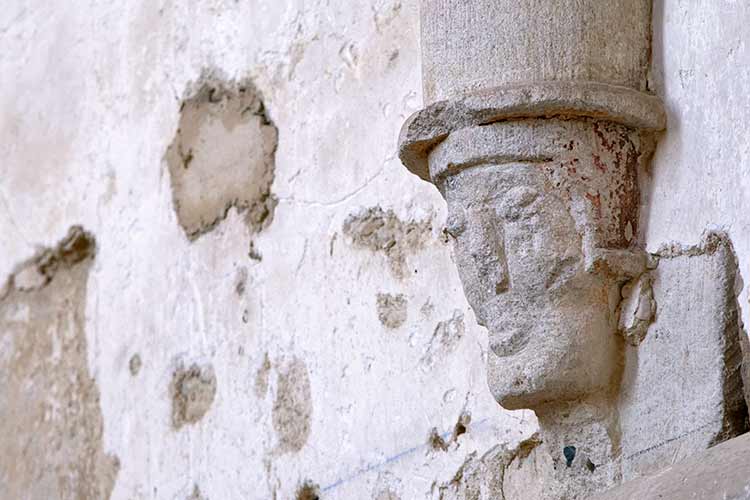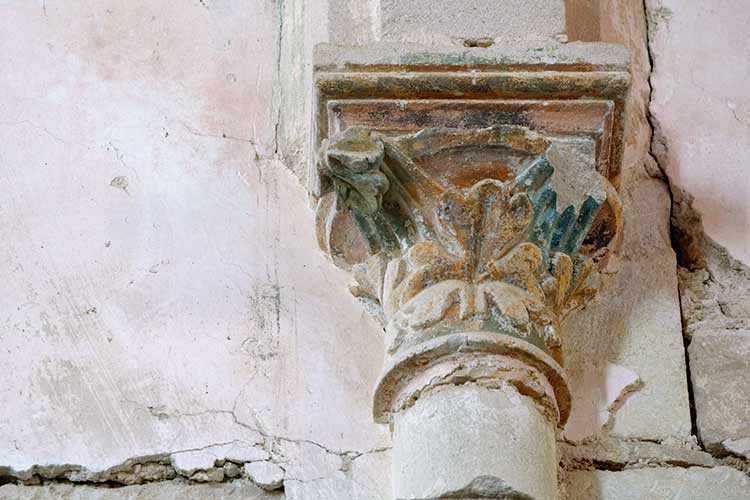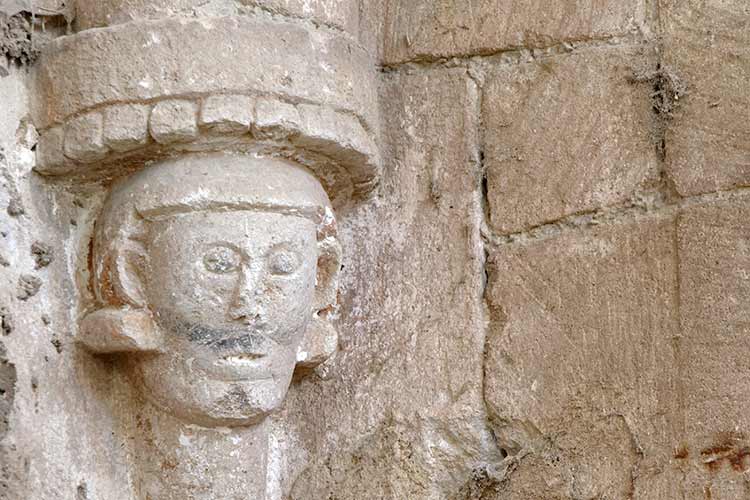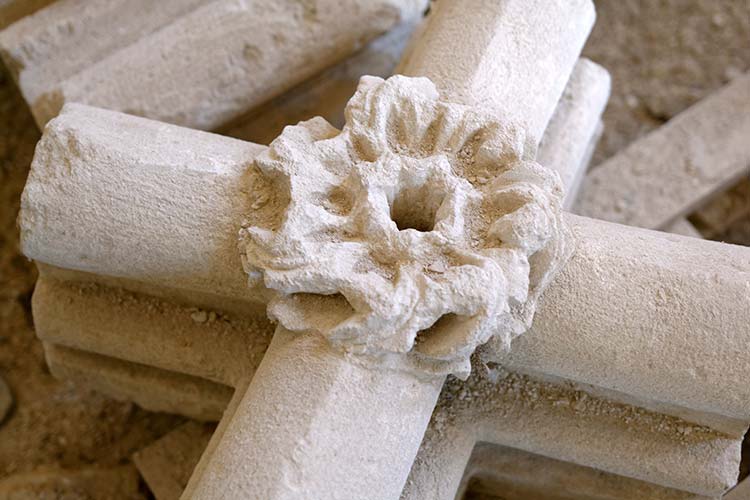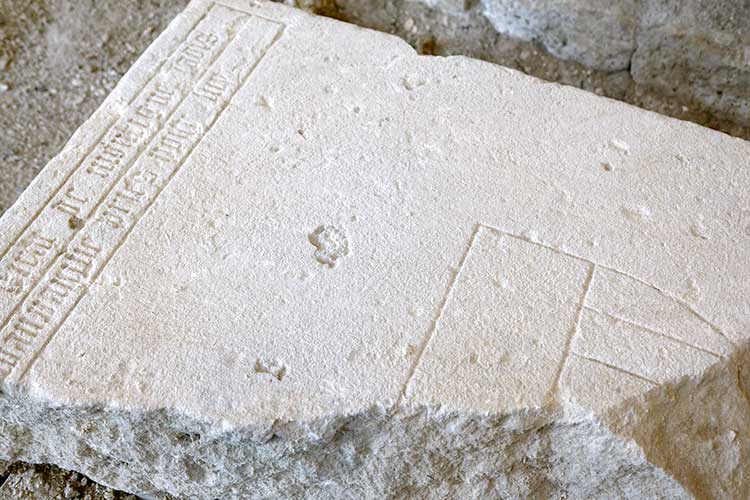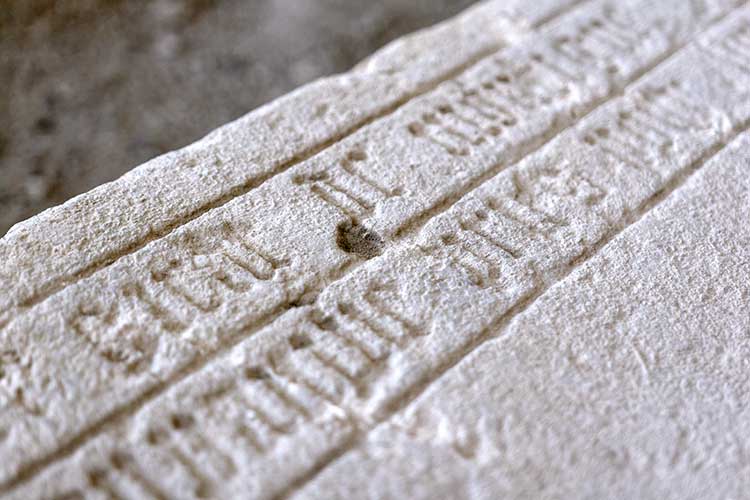1) Clé de voûte du cœur.
Elle est sculptée d'une double rosace et son rebord occidental est orné d'un visage d’homme, certainement un Templier, tourné vers le portail.
2) et 11) Visages sculptés
Le haut du mur de la chapelle est surmonté du côté nord par une corniche à la bourguignonne ornée de modillons en écu qui sont parfois remplacés par des visages sculptés. Ces têtes sont toutes couvertes d'une coiffe dont on voit parfois revêtus les Templiers. Le plus achevé regarde vers l'ancien châtelet du commandeur, au niveau de la première travée. À l'angle occidental du mur sud se trouve une autre tête d´homme qui possède le même style de chevelure.
3) et 4) et 8) et 10) Chapiteaux à feuillages et à crochets.
Ces chapiteaux datent des années 1200 comme en attestent les traces de polychromie bien visibles sur certains d'entre eux. La palette des couleurs est caractéristique du XIIIe siècle.
5) et 7) et 9) Visages sculptés.
À l'intérieur de la chapelle, la nef comportait trois travées doubles dont les voûtes d'ogive reposent alternativement sur trois colonnettes jumelles et une colonnette simple. Ces dernières comportent des chapiteaux à feuillages et des culots représentant des motifs géométriques simples ou des têtes. L'emplacement de ces visages sculptés n’est certainement pas dû au hasard. Ils sont de différentes verses sortes mais la destruction de certains d’entre eux rend l'interprétation de l'ensemble difficile.
6) Chapiteaux à deux têtes.
Ce chapiteau mérite la plus grande attention par son décor de larges feuilles trifoliées d’où semblent sortir deux têtes. L'une d'entre elle, tournée vers le nord, est celle d'un homme à la chevelure s'arrêtant au niveau du cou, à la mode du XIIIe siècle. L'autre personnage tourné vers le couchant a la tête couverte d'un capuchon pour assister aux offices ou bien d'un capuchon de maille que les chevaliers du Temple portaient pour la bataille.
12) Clé de voûte.
Cette clé de voûte provient certainement de la travée du milieu et elle est plus simplement travaillée que celle du chœur.
13) Dalle tumulaire.
Sur ce fragment de dalle sont gravées les armoiries du commandeur Girard de Montagny, prieur de Champagne : un palet de six pièces, au chef. Ce dernier est chargé à dextre d’un écusson à la croix de l'ordre de Saint Jean.
14) Dalle tumulaire.
Sur ce fragment de dalle est gravé l'épitaphe, malheureusement incomplète, du commandeur Girard de Montagny, que l’on peut reconstituer ainsi : « Cy gît frère Girard de Montagny jadis / prieur de Champagne. Priez pour lui. ». Cette épitaphe et les armoiries décrites dans le paragraphe précédent prouvent, sans contestation possible, l'appartenance de Girard à la famille fribourgeoise de Montagny. Il s’agit là l’une des plus anciennes tentatives pour marquer l'appartenance à l'ordre de Saint Jean d’un dignitaire de l'Hôpital.
1) Keystone of the choir
It is carved with a double rosette and its western edge is decorated with a man's face, certainly a Templar, facing the portal.
2) and 11) Sculpted faces
The top of the wall of the chapel wall is surmounted on the north side by a Burgundian cornice decorated with modillions shaped as an escutcheon, which are sometimes replaced by carved faces. These heads are all covered with a headdress which was reportedly worn by the Templars. The most completed one looks towards the former châtelet of the Commander at the level of the first span. At the western corner of the south wall is another male head with the same style of hair.
3) and 4) and 8) and 10) Foliage and hook-type capitals
These capitals date from the 1200s as evidenced by the traces of polychromy clearly visible on some of them. The color palette is characteristic of the 13th century.
5) and 7) and 9) Sculpted faces
Inside the chapel, the nave had three double spans, the rib vaults of which alternately rest on three twin balusters and a single baluster. These latter are comprised of foliage capitals and cap ends representing simple geometric patterns or heads. The location of these carved faces is certainly not coincidental. They are of various kinds, but the destruction of some of them makes the interpretation of the group difficult.
6) Two-headed capitals.
This capital deserves the greatest attention by its decoration of large trifoliate leaves from which two heads seem to emerge. One of them, facing north, is that of a man with his hair stopping at the level of the neck, in the 13th century fashion. The other figure turned towards the setting sun has his head covered with a hood to attend services or with a mesh hood that the knights of the Temple used to wear in battle.
12) Keystone
This keystone certainly comes from the middle span and is not as elaborate as that of the heart.
13) Gravestone
On this fragment of slab are engraved the coat of arms of Commander Girard de Montagny, Prior of Champagne: a quoit made of six pieces in the upper part. The latter motive is bearing on the right side the cross of the order of Saint John.
14) Gravestone
On this fragment of slab is engraved the epitaph, unfortunately incomplete, of the commander Girard de Montagny, which can be reconstructed as follows:
« Here lies brother Girard de Montagny formerly / prior of Champagne. Pray for him. »
This epitaph and the coat of arms described in the preceding paragraph prove, without possible dispute, that Girard belongs to the family of Montagny, a family native of Fribourg. This is one of the earliest attempts to mark membership in the Order of Saint John of a dignitary of the Hospitallars Order.

